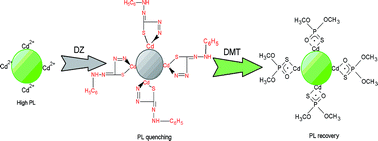Fluorescent switching technology based on fluorescence resonance energy transfer for detecting dimethoate pesticides in environmental water†
Abstract
The development of new, sensitive and simple methods for the rapid detection of dimethoate (DMT) in water is vitally important. A fluorescent probe technique has been developed for the rapid trace detection of pesticide residues. In our study, the method used is based on the fluorescence resonance energy transfer, which is also known as FRET. Dithizone (DZ) was bound to cadmium (Cd) on the surface of CdTe QDs to form a DZ–Cd complex. Then, the fluorescence of the CdTe QDs was immediately quenched because of the FRET between the CdTe QDs and the surface of DZ–Cd complex. After the addition of DMT to the DZ-functionalized QDs, DZ was separated from the surface of the QDs and was replaced by DMT, and the fluorescence of the QDs was restored. This method was validated using water samples spiked with DMT. Two good linear relationships were obtained in the range from 0.01 to 5.0 μg mL−1 and 5.0 to 40 μg mL−1; the detection limit was calculated to be 0.005 μg mL−1, and reasonable recoveries (88.6–95.3%) were achieved for the direct detection of DMT in water samples. This method is rapid, convenient and environmentally acceptable and shows potential for the rapid detection of DTM in water samples.


 Please wait while we load your content...
Please wait while we load your content...